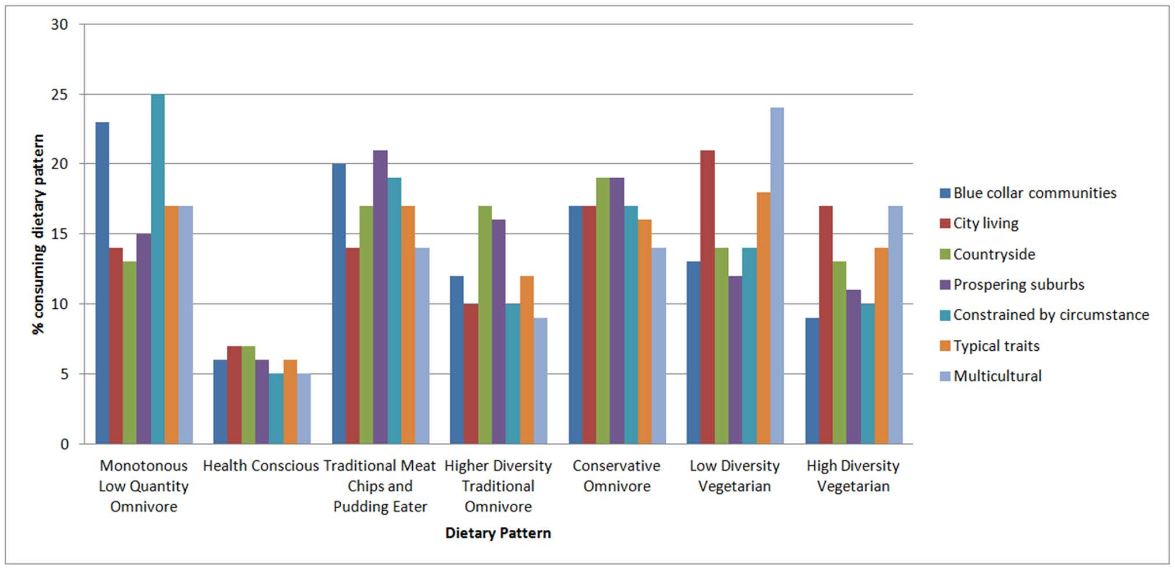About the research
Diet has an important impact on health and can increase the risk of developing chronic diseases such as hypertension and diabetes. In the UK “on average, no population age group meets current dietary recommendations” (Public Health England, 2015). A better understanding of factors influencing diet is important in promotion of healthier dietary choices. However, factors influencing food choice are complex and include social, economic, demographic, environmental and individual aspects.
This study, conducted by researchers from the University of Leeds and Nottingham, investigates how the environment influences women’s diets in the UK. It explores the variations in dietary patterns in two ways: at the large scale of Government Office Region level and using ‘Supergroup’ Output Area Classification, a geodemographic classification for a smaller scale picture. The researchers conducted a cross-sectional analysis using data from the UK Women’s Cohort Study (UKWCS), a large cohort established to investigate associations between diet and health in the UK which recruited 35,372 middle aged women between 1995 and 1999. They applied the geodemographic classifications to the cohort data using GeoConvert and the research shows that there is potential to inform targeted public health dietary interventions by combining the data.
The findings of the study show that dietary patterns vary significantly by both spatial measures. At Government Office Region level, the North West of England has the highest proportion of individuals consuming the least healthy, monotonous diets, while Greater London has the highest proportion of vegetarian diets. Results at Output Area Classification level show that individuals living in Supergroups ‘Countryside’ and ‘Prospering Suburbs’ consume healthier, more diverse diets. They also suggest that women living in ‘Constrained by Circumstance’ and ‘Blue Collar Communities’ consume monotonous, less healthy diets.
Figure 1: Percentage of UKWCS women consuming each dietary pattern by OAC Supergroup (Source: Morris et al., 2016)
The main author of the study, Michelle Morris, was funded by the Economic and Social Research Council and the Medical Research Council through an interdisciplinary PhD studentship and her project explores a spatial analysis of dietary patterns, the cost of these patterns in the UK and their subsequent effect on health outcomes.
Methodology
The study applied two geographic units to postcode level data from the UK Women’s Cohort Study to better understand spatial variations in diet in the UK. A cross-sectional dietary pattern analysis was carried out on a sample of 32,205 women who completed a validated 217 item Food Frequency Questionnaire (FFQ). Data collected by the FFQ was used to identify seven dietary patterns using a k-means cluster analysis (Greenwood et al, 2000). The patterns were named to reflect the types and quantities of food consumed in each pattern:
- “Monotonous Low Quantity Omnivore” – a diet high in white bread, sugar and milk;
- “Health Conscious” – a diet high in fruit and vegetables and wholegrains;
- “Traditional Meat Chips and Pudding Eater” – typified by a white bread, meat, chips and high fat, creamy foods;
- “Conservative Omnivore” – a diet lacking high quantities of any food, but with moderate quantities of most foods, especially potatoes, meat, fish, eggs, fruit and vegetables;
- “Higher Diversity Traditional Omnivore” – a diet similar to the Traditional Meat Chips and Pudding eater but with higher diversity;
- “Low Diversity Vegetarian” – a meat free diet high in wholemeal bread, soya, pulses, fruit and vegetables;
- “High Diversity Vegetarian” – a meat free diet with lots of variety including wholemeal bread, cereals, wholemeal pasta and rice, soya, spreads, nuts, pulses, fruit, vegetables and more.
The healthiness of the dietary patterns was determined by scoring them against the UK dietary recommendations contained in The Eatwell Guide (The Eatwell Plate at the time of study), with the “Health Conscious” pattern being the healthiest and the “Monotonous Low Quantity Omnivore” the least healthy (Morris et al., 2014).
Multinomial logit regression was then used to test whether the area in which the women live, predicts their dietary pattern consumption. The study reports diet according to Government Office Regions across England and the countries Scotland and Wales and to the ‘Supergroups’ from the Output Area Classification of the 2001 Census. Government Office Regions and Output Area Classifications were assigned via the postcode unit for each woman in the cohort using GeoConvert, a UK Data Service tool that makes it easy to match UK postcodes, census geographies and convert data between them.
Findings for policy
Estimating dietary patterns at a small area level using a classification such as Output Area Classification, allows for smarter targeting of public health interventions, to improve diet and general health. The study shows that dietary patterns vary across the UK and these results could help to target interventions within the areas most at risk of consuming a poor diet. For example, women living in a ‘Blue Collar Community’, have significantly increased risk of consuming the least healthy “Monotonous Low Quantity Omnivore” dietary pattern and a significantly reduced risk of consuming the two healthiest dietary patterns (“Health Conscious” and “High Diversity Traditional Omnivore”). This suggests that it would be worthwhile implementing a healthy diet promotion in these types of areas which would encourage introducing more variety into diets and, as highlighted by the researchers, it “could be done through social services interventions in specific communities, or at a GP practice level in local communities“.
To read the report in full:
Morris, M.A., Clarke, G.P., Edwards, K.L., Hulme, C., Cade, J.E. (2016) ‘Geography of diet in the UK Women’s Cohort Study: a cross-sectional analysis’, Epidemiology Open Journal, 1(1), pp. 20-32. doi: 10.17140/EPOJ-1-104

